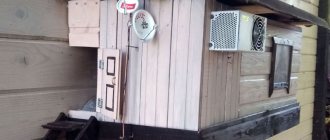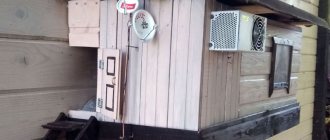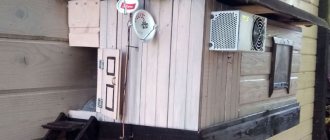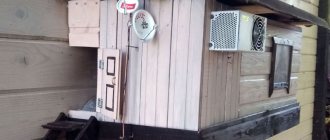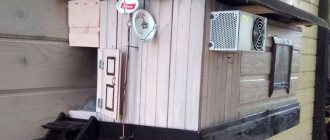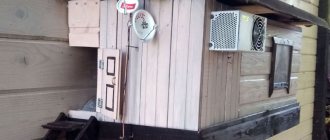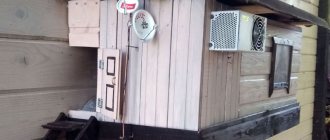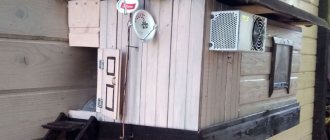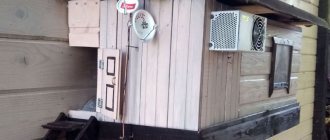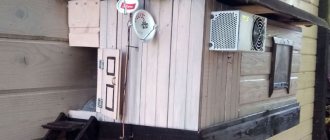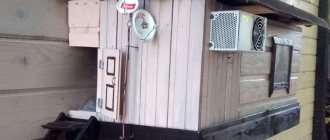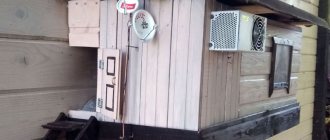Another homemade product for those who are bored at home
I needed a couple of antennas for digital, in places with “not the best reception”... I went shopping (this was before self-isolation - if it’s relatively budget-friendly, then it’s complete G. The more expensive one looks decent, but how it works is questionable.
- if it’s relatively budget-friendly, then it’s complete G. The more expensive one looks decent, but how it works is questionable.
I decided to make something homemade. It was somehow awkward to “twist” an antenna from a piece of cable (although rumor has it it works) - I wanted something simple, but more decent and advanced
In fact, the one I made is not radically more complicated, but somehow more “solid” or something. And the results of its testing were very encouraging, so I decided to sketch out a short description of what and how, in case someone else finds it useful 
... even if my street cats have a “normal” antenna on their house, what can you do without an antenna?!
The wire is not all finished yet, now we’ll assemble something!

In the places described, I previously used home-made broadband log-periodic antennas, probably since the “beginning of perestroika.” They worked well in analog and not only on UHF, but “for some reason, digital was too tough for them.” I didn’t really delve into the essence of the reasons, I removed them and began to think about what to replace them with. Here is one of them, waiting for a place in the trash
They worked well in analog and not only on UHF, but “for some reason, digital was too tough for them.” I didn’t really delve into the essence of the reasons, I removed them and began to think about what to replace them with. Here is one of them, waiting for a place in the trash
A little history
In the early 60s of the last century, our compatriot Kharchenko K.P. developed a simple flat zigzag antenna with good characteristics.
Copyright certificate No. 138277 for an invention called “Band directional antenna” was issued to Konstantin Pavlovich Kharchenko in 1961 (according to his application dated June 16, 1960). In the same year, materials were published in the magazine “Radio” for repetition by radio amateurs.
The antenna is not critical to materials and dimensions during manufacturing, has a simple good match with the reduction cable, and it successfully combines multiple elements of a common-mode antenna array with a single feed point.
TV antenna made from tin cans
To assemble a simple DIY antenna for digital TV, use coaxial wire and several aluminum or tin cans. It is also advisable to prepare a small plastic pipe. The choice of material for the base is obvious - a plank made of wood.
Only tin or aluminum cans can provide signal reception. Glass or plastic is suitable for this.
There is only one requirement for the material - the inner surface must be smooth, not ribbed. Anyone can design a TV antenna by following simple step-by-step instructions:
- First, wash the jars thoroughly and then wait until they dry.
- Treat the end of the antenna wire.
- Remove the insulation from the central core, and then twist the braid.
- You have two conductors that need to be attached to the cans.
- The conductors can be soldered if desired, if you have the necessary tool at hand. An alternative option is to secure the conductors with self-tapping screws.
- Twist loops at the ends of the conductors. You need to insert self-tapping screws into them, and only then secure them to the cans.
- Use fine-grit sandpaper to thoroughly clean the metal surface of the cans, removing the paint.
- Secure the cans to a base, which can be a piece of wood or a plastic pipe.
- There are no universal measurements. Everything needs to be calculated individually.
- Plug the antenna cable into your TV or receiver and try to tune in to digital channels.
From beer cans
Tin and aluminum beer cans can be used, but first remove the paint with fine-grit sandpaper. Do not be under any illusions, the option considered is an emergency solution. Therefore, under optimal circumstances, only a few TV channels will be broadcast in good quality and without interference.
Without a doubt, the final result is determined by how far away the signal repeater is located. The cause of additional interference may be the landscape, trees, or tall buildings. Of course, the quality of the TV antenna also plays a role.
Theory and calculations
The described antenna, in theory, has a horizontal “figure-of-eight” radiation pattern and a relatively high gain, which can be further increased by using a reflector/reflector.
To obtain maximum gain on all channels, it is necessary to make an antenna approximately in the middle of the range between the multiplexes used.
Finding (for calculations) the frequencies of multiplexes used in your region is easy,
for example, a request like “dvb-t2 channel frequencies” + “Krasnodar”
I found something like this:
The middle, between “my” two multiplexes, is 700 MHz - we will calculate the antenna at this frequency.
As a basis for calculating the dimensions of the antenna, we take the drawing of its author
Calculate the wavelength: λ = 300 / f [m]
300/700 = 0.428m, approximately 43cm length of each side of the rhombus
λ/4
=43/4= 10.75
The total length of the material we need (11cm*8=88cm) is less than a meter. The distance between the reduction contacts, where we will solder the cable, is 10-12mm (the standard value for this antenna for frequencies below 900 MHz).
I will make a simple antenna, without a reflector, however, to further increase the gain of this antenna, it is quite possible to install it behind it
for example, from a metal mesh/grill, foil material or simply a metal plate. Its dimensions should be approximately 20 percent larger than the dimensions of the antenna and it should be located at a distance of ƛmax/7. For my case: wavelength (channel 39) 300/618, it turns out...49/7= that is, about 7cm
For those who are too lazy to do the calculations themselves
— you can use an online calculator, the results will differ only slightly from those I received. Here, for example, this one - here you immediately enter the frequencies of two multiplexes and get the dimensions of the antenna (without a reflector) Or another option, with a reflector - I really want to note that in the second option a slightly different calculation option is used, different from the author’s. An antenna with angles other than 90° is assumed and the reflector distance is calculated as λ/8
To make the antenna sheet, it is recommended to use aluminum or copper (copper is easily soldered) with a diameter of 3 mm and higher - the larger the diameter, the more broadband the antenna is. You can use tubes; the thickness of the walls is not important, since only the surface of the material is used (in fact, you can wrap any dielectric with foil to obtain the required material). However, in my opinion, the easiest way is to buy a meter of large-gauge copper wire at an electrical supply store.
Modern digital television broadcasting
Advantages of the UHF range
In recent years, noticeable changes have been observed in the terrestrial television broadcasting sector, which have a certain impact on which UHF antenna is optimal for remote areas
It is especially important that today almost all television broadcasting is focused on the digital UHF range, to cover which the same decimeter antennas will be required
One of the reasons why these frequencies are preferred is the well-known economic factor. The fact is that modern equipment of transmitting stations, as well as wave channels (feeders) and antennas, have become much cheaper. Let's add to this the reduction in maintenance costs for transmission systems and other station devices.
In addition, UHF antennas, complete with appropriate digital equipment, provide the following advantages:
- If you use a UHF antenna for personal purposes, you will be able to receive a signal even in places remote from the city limits that were previously considered inaccessible;
- In remote areas, range coverage is ensured by the power of transmitters without the need to use relay towers;
- Another advantage of receivers of this class is the low sensitivity of the digital UHF signal to interference.
Note! The digital signal has certain disadvantages, most often manifested when there are any mismatches in the transmitting path. The consequence of this is the appearance of characteristic gaps in the image even if its quality is quite high.
The cause of such violations can be noticeable phase distortions caused by deviations of the path characteristics from the norm
The consequence of this is the appearance of characteristic gaps in the image even if its quality is quite high. The cause of such violations can be noticeable phase distortions caused by deviations of the path characteristics from the norm.
Features of UHF antennas
A modern UHF antenna differs from its predecessors in that its individual qualities (primarily the amplifying effect) begin to come first. Therefore, it can be used at almost any (within line of sight) distance from the transmitting station. When using such an antenna, due to the processing of relatively weak signals in the amplifier, it is possible to achieve high image quality. The main parameters of the receiving and amplifying path are specified by the following technical requirements:
Its amplitude-frequency response (AFC) should be as uniform as possible over the entire band of received frequencies (see the graph in the figure below);
Frequency response graph
- The presence of small dips and peaks on it should not lead to the appearance of phase distortions and discontinuities in the image;
- The electronic part of the receiving path must be coordinated with the feeder over the entire range of received frequencies.
If these conditions are met, the antenna for digital TV does not require additional devices to ensure its adaptation to local reception conditions.
Antenna assembly
Let's remove the insulation from a piece of wire one meter long.
I got a wire with a diameter of 4.5mm
The tools you will need are a vice and a hammer. Measure approximately 11cm each and bend at an angle of 90°
The end result is to get such a “geometric” figure 
We cut off the excess and solder the ends. It should look something like this...
Solder the cable as shown in the photo.
We lay the cable along one side of the square and secure it with clamps. This arrangement of the cable is necessary for its coordination (there are different opinions, not everyone agrees with this statement).
When using a reflector, the antenna sheet at the extreme points of the squares can also be secured using metal stands, for example, soldered onto the remains of the same copper wire - there are points with zero potential (highlighted in green). In other places, fastening is allowed only through a dielectric.
Installation safety precautions
For reliable operation of such antennas, it is necessary to place them above the ground at a level of 7-10 meters. Therefore, during installation it is necessary to strictly follow the safety rules:
- Do not install the structure in heavy rain or heavy fog.
- It is not advisable to go upstairs alone, especially in icy, cold, or snowy conditions.
- If it is necessary to climb a shaky structure or high-altitude work is carried out in dangerous places, then a fixed mounting belt is required.
After proper installation, homemade antennas work no worse than factory ones, with significant budget savings.
Tests
And finally, a performance check and a rough
assessment of the quality of the resulting antenna.
In fact, everything is simple with the test - turn it on, it works! And to evaluate whether the game was “worth the candle,” let’s compare the parameters of the received signal from the manufactured antenna with the one I’m already using at the dacha, with a declared gain of 11dBi
And to evaluate whether the game was “worth the candle,” let’s compare the parameters of the received signal from the manufactured antenna with the one I’m already using at the dacha, with a declared gain of 11dBi
The antenna is installed in the attic of a country house, at a distance of approximately 16 km from the tower.
Signal level: factory stationary antenna on the left / homemade on the right
At first glance, the difference is only 1% (95 versus 94) - but this is not a completely correct comparison, since my external antenna is connected through a splitter, which further weakens the signal.
AUGRA installation options
Installation of automatic control gear must comply with the following requirements:
- ensuring reliable fastening of the radio receiver to the car, preventing movement when exposed to various mechanical loads (wind, bending, etc.);
- ensuring tight contact with the body, which acts as a mass, which significantly reduces the level of interference and improves signal quality.
All options for installing a receiving radio antenna come down to three main methods for fixing the automatic control gear on a vehicle:
- mortise mounting using a through hole drilled in the roof or other part of the body;
- magnetic mount using a magnetic antenna base;
- a pin mount, which is a mechanical fixation of the antenna rod for a car radio on a special clamp-type bracket.
APRA mortise mount
The mounting pin of the radio antenna base is inserted into the through hole, and a nut is screwed onto it from inside the passenger compartment. The advantages of the “mortise fastening” method include:
- the strength of the device, reducing the likelihood of it being stolen;
- stability of the operating parameters of the antenna-feeder system after installation.
Among the disadvantages, the following circumstance is noted: the edges of the drilled hole are centers of corrosion of the metal body, therefore it is recommended to use standard technological holes.
Important! In the fastening area, it is necessary to strip the metal of paint to ensure reliable conductive contact of the nut, as an element of the antenna, with the metal of the car body. On rice
Below is the antenna base with a pin and a hole in the roof of the car prepared for installing the AUGRA
In Fig. Below is an antenna base with a pin and a hole in the roof of the car prepared for installing the AUGRA.
Antenna base for flush mounting
Magnetic mount APRA
The magnetic fastening of the antenna is provided by magnets located at its base - the sole. Magnets can be purchased separately from the antenna device. The most popular magnets are with diameters from 90 to 170 mm. The stability of the automatic control gear directly depends on the diameter of the magnet.
The antenna is attached to the magnet through two types of connectors:
- The DV connector is adapted to most antenna systems and allows for adjustment of the installation angle;
- The PL connector is more reliable in terms of maintaining strict vertical installation.
In Fig. Magnetic antenna mounts with DV and PL bases are shown below.
Magnetic antenna mounts with DV and PL bases
The advantages of the magnetic fastening method include the following points:
- ease of installation or dismantling;
- relatively high stability of the automatic control gear is ensured while maintaining the optimal size of the magnetic base;
- capacitive coupling of the magnetic base with the metal of the body creates a kind of imitation of “mass” necessary for the operation of the receiving antenna;
- the ability to move when setting up equipment.
Disadvantages include:
- low strength of fixation on the body;
- ease of abduction;
- the possibility of shifting, which leads to the need for additional adjustments.
APRA pin mount
For the technical implementation of the pin fastening, a clamp bracket is installed on the protruding part of the car body (fender, trunk, etc.), the clamping bolts of which, with their pointed ends, create mass contact necessary for high-quality radio reception.
In Fig. The pin mount on the bracket is shown below.
Pin mount
One of the advantages of this method is the possibility of fixing antenna devices on vehicles with non-uniform and protruding metal surfaces (truck cranes, open cars, special equipment).
The disadvantages include:
- low mechanical strength;
- difficult setup and coordination of automatic control gear.
Assessing the performance of the antenna
Let's try to make a more correct comparison by connecting through the splitter input.
Well, in addition, for clarity, let’s add the number of participants List of antennas taking part in the comparison:
1. External antenna Funke BM 4551 external long-range,
declared gain, from some sources (bought at Yulmart), up to 16dB
2. There is an old UHF loop antenna, from TV Electronica 313d, I must say, despite its simplicity, it’s a very good antenna, that’s why it’s been preserved 
3. I went to the store and bought for comparison in the review one of the cheapest, such as a symmetrical vibrator (100% the most purchased by pensioners, due to the low price).
I will carry out all “measurements” at one point, located as close as possible to the external antenna - its location was experimentally selected based on the maximum signal, so we can say that the conditions are approximately the same
So, we have already seen the signal level from the external antenna at 95% (at the time of current measurements it showed 94%), we take it as a standard. All comparisons are made by connecting antennas to the input on the splitter, to which an external antenna is usually connected.
Loop antenna, from Electronics 82% on 39 multiplex and 66% on 60
Budget with “horns” - 62%/38% (on the verge of losing the broadcast)
- 62%/38% (on the verge of losing the broadcast)
Double square - 92% on both multiplexes, about a couple of percent less than the external one
Out of curiosity, I decided to check the work of the reflector, which is easy to make from any metal mesh, plate or even foil... It REALLY works noticeably! The level rose to 96%!, which is even higher than the stationary one, with a declared gain of 11dB.
The most interesting thing is the object that I used as a reflector! 
There was no foil in the house; the only thing available with a metal surface of the required size was... a laptop cover (I have a metal case). But the main thing is the result! It’s clear that I’m not going to “tie” the laptop to the antenna, and its amplification is enough for me without a reflector
DIY double or triple square antenna for Digital TV
Many summer residents do not want to buy good antennas for their houses, since they do not live in them permanently. In order to watch TV programs while taking a break from gardening, they often use devices with a characteristic impedance of 75 ohms. The choice in favor of homemade double square antennas is due to the low cost of consumables, as well as the speed of manufacturing.
Conclusion:
I can confidently recommend repeating it!
Simple, “cheap and tasty”... One of the simplest, indoor antenna mounts... with ordinary suction cups - if you’re lucky with the direction to the television center
The next antenna "recommended for repetition" is... log periodic
“Crazy hands” were with you. Good luck and good mood to everyone! ☕
Good luck and good mood to everyone! ☕
Signal amplification circuits
A signal amplifier can be purchased ready-made from a factory (for example, VVK or Terra) or made independently. There are various types of amplifiers - from the simplest boards that fit on the antenna antenna, to large set-top boxes powered from the electrical network. In addition, there are models for amplifying terrestrial and satellite signals. An antenna with an installed amplifier is called active.
Signal amplification circuits.
To make an amplifier, you will need three capacitors with a capacity of 1 nF and a resistance with a nominal value of 1 kOhm. To power such a device, a constant voltage of 3 to 5 V is used. The device does not require adjustment, but the degree of amplification is adjusted by setting a resistance of a different value (to lower the degree of amplification, it is necessary to increase the resistance). Such an amplifier is not broadband and is applicable only for the shortwave range.
For broadband amplification when receiving signals over long distances, transistor devices are used, the circuit diagrams of which are given below. In the process of self-assembly of such devices, it is necessary to produce printed circuit boards with tracks. When using wires to connect elements, the amount of interference increases, which will reduce the gain of the device.
For an amplifier based on KT368 you will need resistances and capacitors with the following parameters:
- 100 Ohm (R1 and R4);
- 470 Ohm (R2);
- 51 kOhm (R3);
- 1000 pF (C1);
- 33 pF (C2);
- 15 pF (C4 and C3).
The assembled amplifier is installed as close as possible to the receiver and can be used for any type of antenna. It does not require adjustment and operates from a DC source with a voltage of 9 V. To expand the frequency range, amplifiers are used, built on a common transistor base. These devices also do not require additional adjustment of operating parameters.
Television signal amplification circuits.
During the assembly process you will need the following components:
- 51 Ohm (R1);
- 10 kOhm (R2);
- 15 kOhm (R3);
- 1 kOhm (R4);
- The capacitors have the same rating as in a common emitter circuit. The amplifier circuit uses a choke coil, which is wound from 300 turns of 0.1 mm wire (PEV type) on a ferrite ring. In the case of a very weak signal, it is possible to use multi-stage circuits operating from direct current with a voltage of 12 V and built on two transistors of the GT311D type. The amplifier circuit for long-range antennas uses:
- 680 Ohm (R1);
- 75 kOhm (R2);
- 1 kOhm (R3);
- 150 kOhm (R4);
- 100 pF (C1, C2, C4);
- 6800 pF (C3);
- 15 pF (C5);
- 3.3 pF (C6);
- 100 µH (L1);
- 25 µH (L2);
- homemade choke made from 25 turns of PEV2 wire with a diameter of 0.8 mm (L3).
Material on the topic: How to make a Kharchenko antenna with your own hands.
Primary requirements
Receiving devices operating in the decimeter wave range have a single principle. The picture will definitely be clear if the television signal is strong enough. To make sure of this, you can ask your friends or neighbors in the country who use a digital antenna if their TV shows.
To reduce the level of interference behind the antenna, you can install a reflector yourself. It is used for devices that pick up analog signals and can affect the digital reception quality of square-type antennas. The reflector is installed behind the central square of the device.
No complex calculations required. To be completely sure, you can calculate the required square size. To do this, you need to find out the wavelength and divide it by 4. The resulting number will indicate the desired side of the outer square. The sides of the central squares should be 2 cm larger than the sides of the side ones.
Materials for the manufacture of antennas are selected taking into account current conductivity and the ability to change shape. Copper or aluminum tube and wire conduct current well, bend and are suitable for long-distance reception. Glass elements wrapped in foil can be used.
The receiving device must have several lanes and be directed towards the repeater, without encountering obstacles in the form of trees and houses along the way.
DIY antenna. Calculating the location of the tower is simple - by turning the antenna from side to side until a picture or message appears on the TV screen indicating sufficient signal strength.
